Clinical Integration Specialty Practice 2: Elderly Falls Research
VerifiedAdded on 2020/03/16
|7
|1633
|183
Report
AI Summary
This report presents a clinical integration study focused on the issue of falls among the elderly in healthcare settings. The research investigated the environmental factors, such as lighting and flooring, and the impact of nurse-patient relationships on fall occurrences. Data collection methods included observation, interviews, dialogues, and questionnaires conducted in various elderly care institutions in Australia. The study found that the physical environment and the quality of interactions between nurses and patients significantly influence the incidence of falls. The report emphasizes the importance of appropriate environmental design and strong patient-nurse relationships in reducing fall risks, highlighting the need for healthcare institutions to prioritize these aspects to ensure patient safety and well-being. The findings suggest that psychological anticipation of falls is a major factor and that nurses can play a key role in mitigating this through patient engagement and distraction techniques. The report concludes by recommending a multi-faceted approach that includes physical, emotional, and medical strategies to minimize falls and improve the quality of care for elderly patients.
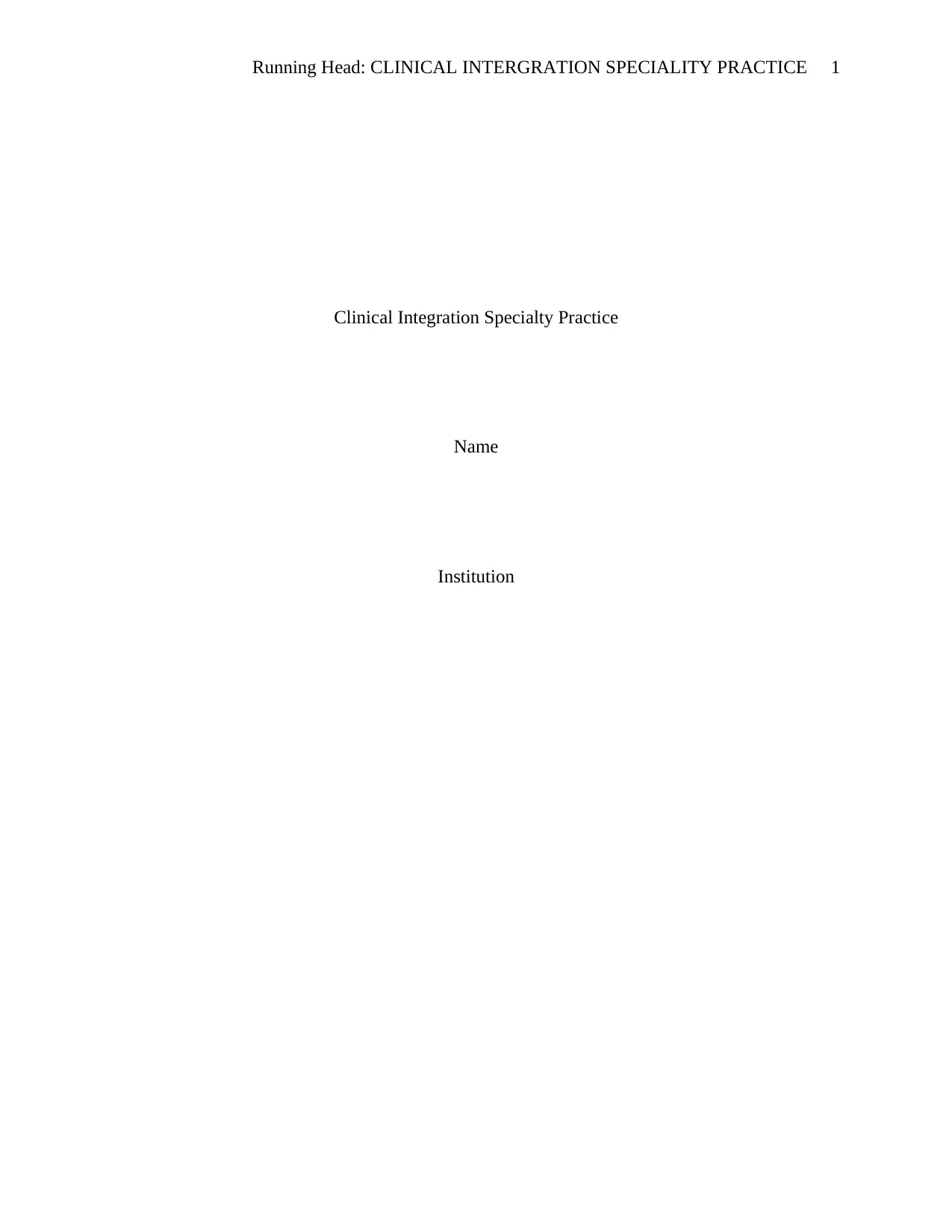
Running Head: CLINICAL INTERGRATION SPECIALITY PRACTICE 1
Clinical Integration Specialty Practice
Name
Institution
Clinical Integration Specialty Practice
Name
Institution
Paraphrase This Document
Need a fresh take? Get an instant paraphrase of this document with our AI Paraphraser
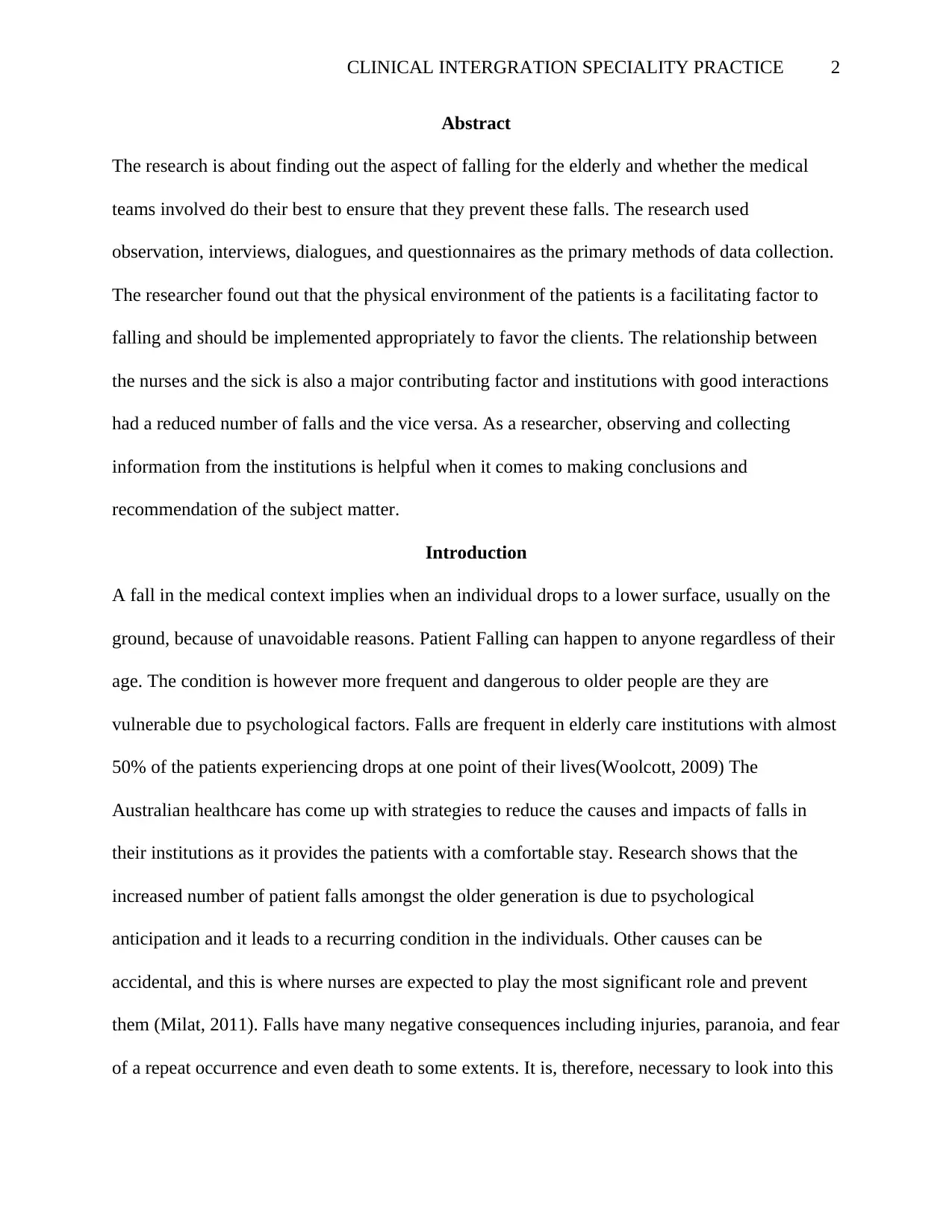
CLINICAL INTERGRATION SPECIALITY PRACTICE 2
Abstract
The research is about finding out the aspect of falling for the elderly and whether the medical
teams involved do their best to ensure that they prevent these falls. The research used
observation, interviews, dialogues, and questionnaires as the primary methods of data collection.
The researcher found out that the physical environment of the patients is a facilitating factor to
falling and should be implemented appropriately to favor the clients. The relationship between
the nurses and the sick is also a major contributing factor and institutions with good interactions
had a reduced number of falls and the vice versa. As a researcher, observing and collecting
information from the institutions is helpful when it comes to making conclusions and
recommendation of the subject matter.
Introduction
A fall in the medical context implies when an individual drops to a lower surface, usually on the
ground, because of unavoidable reasons. Patient Falling can happen to anyone regardless of their
age. The condition is however more frequent and dangerous to older people are they are
vulnerable due to psychological factors. Falls are frequent in elderly care institutions with almost
50% of the patients experiencing drops at one point of their lives(Woolcott, 2009) The
Australian healthcare has come up with strategies to reduce the causes and impacts of falls in
their institutions as it provides the patients with a comfortable stay. Research shows that the
increased number of patient falls amongst the older generation is due to psychological
anticipation and it leads to a recurring condition in the individuals. Other causes can be
accidental, and this is where nurses are expected to play the most significant role and prevent
them (Milat, 2011). Falls have many negative consequences including injuries, paranoia, and fear
of a repeat occurrence and even death to some extents. It is, therefore, necessary to look into this
Abstract
The research is about finding out the aspect of falling for the elderly and whether the medical
teams involved do their best to ensure that they prevent these falls. The research used
observation, interviews, dialogues, and questionnaires as the primary methods of data collection.
The researcher found out that the physical environment of the patients is a facilitating factor to
falling and should be implemented appropriately to favor the clients. The relationship between
the nurses and the sick is also a major contributing factor and institutions with good interactions
had a reduced number of falls and the vice versa. As a researcher, observing and collecting
information from the institutions is helpful when it comes to making conclusions and
recommendation of the subject matter.
Introduction
A fall in the medical context implies when an individual drops to a lower surface, usually on the
ground, because of unavoidable reasons. Patient Falling can happen to anyone regardless of their
age. The condition is however more frequent and dangerous to older people are they are
vulnerable due to psychological factors. Falls are frequent in elderly care institutions with almost
50% of the patients experiencing drops at one point of their lives(Woolcott, 2009) The
Australian healthcare has come up with strategies to reduce the causes and impacts of falls in
their institutions as it provides the patients with a comfortable stay. Research shows that the
increased number of patient falls amongst the older generation is due to psychological
anticipation and it leads to a recurring condition in the individuals. Other causes can be
accidental, and this is where nurses are expected to play the most significant role and prevent
them (Milat, 2011). Falls have many negative consequences including injuries, paranoia, and fear
of a repeat occurrence and even death to some extents. It is, therefore, necessary to look into this
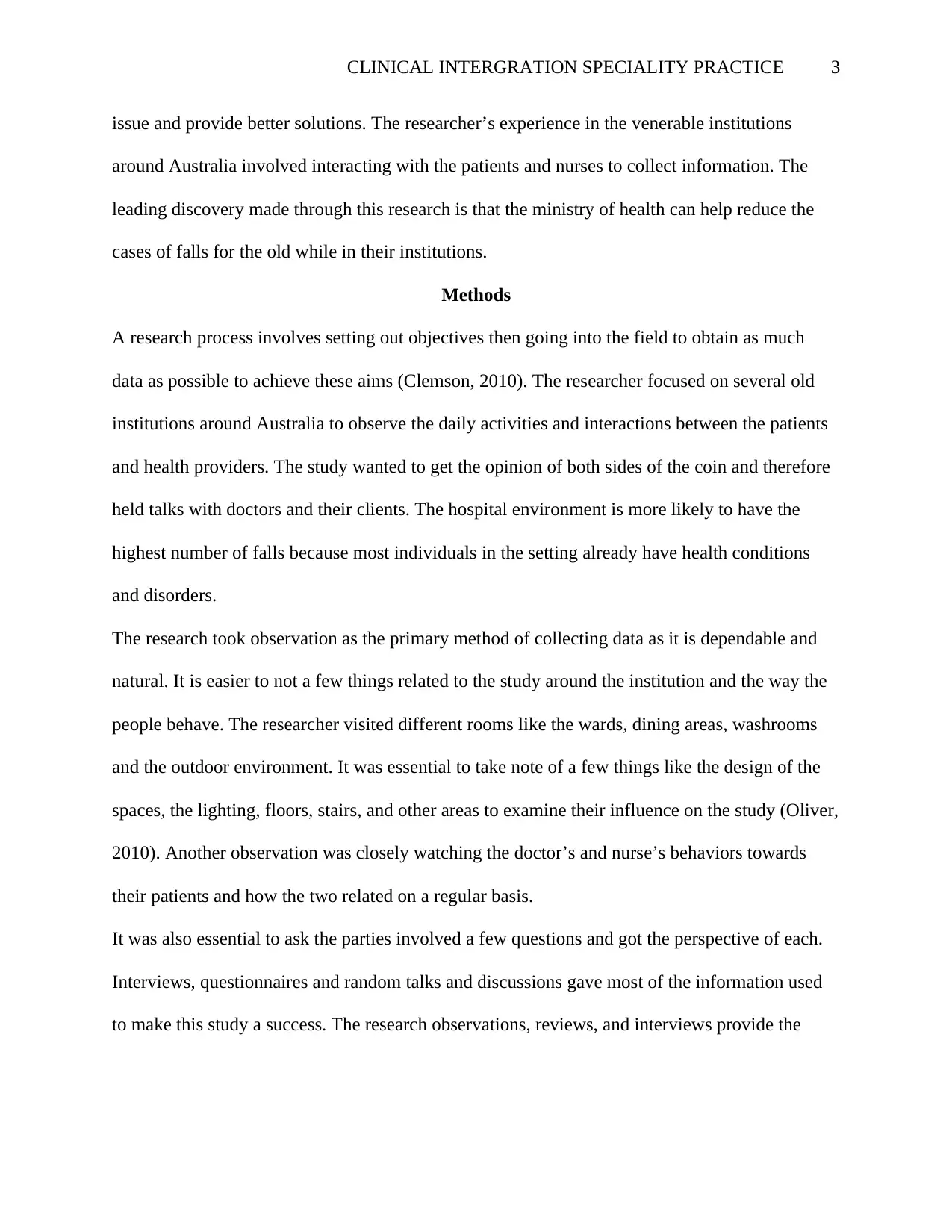
CLINICAL INTERGRATION SPECIALITY PRACTICE 3
issue and provide better solutions. The researcher’s experience in the venerable institutions
around Australia involved interacting with the patients and nurses to collect information. The
leading discovery made through this research is that the ministry of health can help reduce the
cases of falls for the old while in their institutions.
Methods
A research process involves setting out objectives then going into the field to obtain as much
data as possible to achieve these aims (Clemson, 2010). The researcher focused on several old
institutions around Australia to observe the daily activities and interactions between the patients
and health providers. The study wanted to get the opinion of both sides of the coin and therefore
held talks with doctors and their clients. The hospital environment is more likely to have the
highest number of falls because most individuals in the setting already have health conditions
and disorders.
The research took observation as the primary method of collecting data as it is dependable and
natural. It is easier to not a few things related to the study around the institution and the way the
people behave. The researcher visited different rooms like the wards, dining areas, washrooms
and the outdoor environment. It was essential to take note of a few things like the design of the
spaces, the lighting, floors, stairs, and other areas to examine their influence on the study (Oliver,
2010). Another observation was closely watching the doctor’s and nurse’s behaviors towards
their patients and how the two related on a regular basis.
It was also essential to ask the parties involved a few questions and got the perspective of each.
Interviews, questionnaires and random talks and discussions gave most of the information used
to make this study a success. The research observations, reviews, and interviews provide the
issue and provide better solutions. The researcher’s experience in the venerable institutions
around Australia involved interacting with the patients and nurses to collect information. The
leading discovery made through this research is that the ministry of health can help reduce the
cases of falls for the old while in their institutions.
Methods
A research process involves setting out objectives then going into the field to obtain as much
data as possible to achieve these aims (Clemson, 2010). The researcher focused on several old
institutions around Australia to observe the daily activities and interactions between the patients
and health providers. The study wanted to get the opinion of both sides of the coin and therefore
held talks with doctors and their clients. The hospital environment is more likely to have the
highest number of falls because most individuals in the setting already have health conditions
and disorders.
The research took observation as the primary method of collecting data as it is dependable and
natural. It is easier to not a few things related to the study around the institution and the way the
people behave. The researcher visited different rooms like the wards, dining areas, washrooms
and the outdoor environment. It was essential to take note of a few things like the design of the
spaces, the lighting, floors, stairs, and other areas to examine their influence on the study (Oliver,
2010). Another observation was closely watching the doctor’s and nurse’s behaviors towards
their patients and how the two related on a regular basis.
It was also essential to ask the parties involved a few questions and got the perspective of each.
Interviews, questionnaires and random talks and discussions gave most of the information used
to make this study a success. The research observations, reviews, and interviews provide the
⊘ This is a preview!⊘
Do you want full access?
Subscribe today to unlock all pages.

Trusted by 1+ million students worldwide
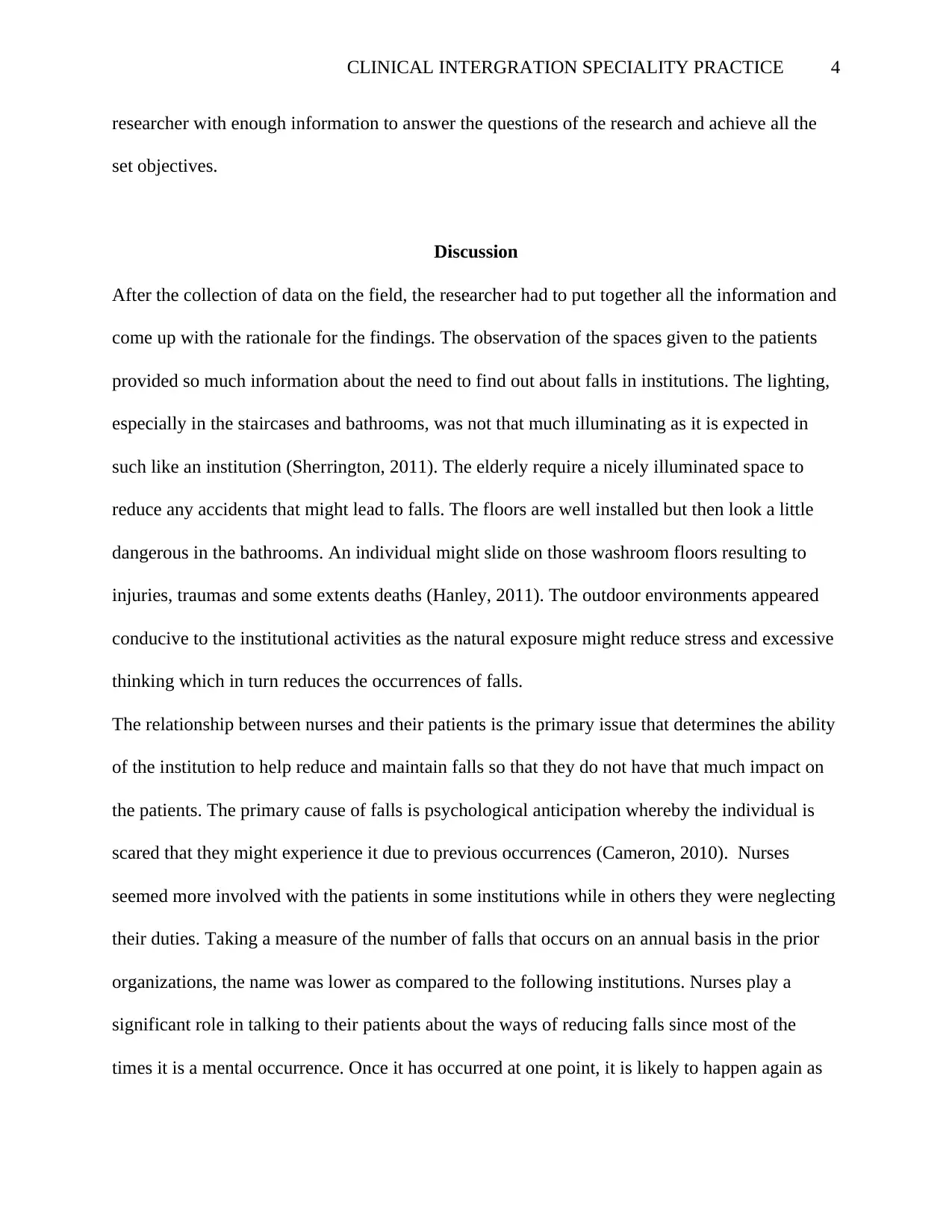
CLINICAL INTERGRATION SPECIALITY PRACTICE 4
researcher with enough information to answer the questions of the research and achieve all the
set objectives.
Discussion
After the collection of data on the field, the researcher had to put together all the information and
come up with the rationale for the findings. The observation of the spaces given to the patients
provided so much information about the need to find out about falls in institutions. The lighting,
especially in the staircases and bathrooms, was not that much illuminating as it is expected in
such like an institution (Sherrington, 2011). The elderly require a nicely illuminated space to
reduce any accidents that might lead to falls. The floors are well installed but then look a little
dangerous in the bathrooms. An individual might slide on those washroom floors resulting to
injuries, traumas and some extents deaths (Hanley, 2011). The outdoor environments appeared
conducive to the institutional activities as the natural exposure might reduce stress and excessive
thinking which in turn reduces the occurrences of falls.
The relationship between nurses and their patients is the primary issue that determines the ability
of the institution to help reduce and maintain falls so that they do not have that much impact on
the patients. The primary cause of falls is psychological anticipation whereby the individual is
scared that they might experience it due to previous occurrences (Cameron, 2010). Nurses
seemed more involved with the patients in some institutions while in others they were neglecting
their duties. Taking a measure of the number of falls that occurs on an annual basis in the prior
organizations, the name was lower as compared to the following institutions. Nurses play a
significant role in talking to their patients about the ways of reducing falls since most of the
times it is a mental occurrence. Once it has occurred at one point, it is likely to happen again as
researcher with enough information to answer the questions of the research and achieve all the
set objectives.
Discussion
After the collection of data on the field, the researcher had to put together all the information and
come up with the rationale for the findings. The observation of the spaces given to the patients
provided so much information about the need to find out about falls in institutions. The lighting,
especially in the staircases and bathrooms, was not that much illuminating as it is expected in
such like an institution (Sherrington, 2011). The elderly require a nicely illuminated space to
reduce any accidents that might lead to falls. The floors are well installed but then look a little
dangerous in the bathrooms. An individual might slide on those washroom floors resulting to
injuries, traumas and some extents deaths (Hanley, 2011). The outdoor environments appeared
conducive to the institutional activities as the natural exposure might reduce stress and excessive
thinking which in turn reduces the occurrences of falls.
The relationship between nurses and their patients is the primary issue that determines the ability
of the institution to help reduce and maintain falls so that they do not have that much impact on
the patients. The primary cause of falls is psychological anticipation whereby the individual is
scared that they might experience it due to previous occurrences (Cameron, 2010). Nurses
seemed more involved with the patients in some institutions while in others they were neglecting
their duties. Taking a measure of the number of falls that occurs on an annual basis in the prior
organizations, the name was lower as compared to the following institutions. Nurses play a
significant role in talking to their patients about the ways of reducing falls since most of the
times it is a mental occurrence. Once it has occurred at one point, it is likely to happen again as
Paraphrase This Document
Need a fresh take? Get an instant paraphrase of this document with our AI Paraphraser
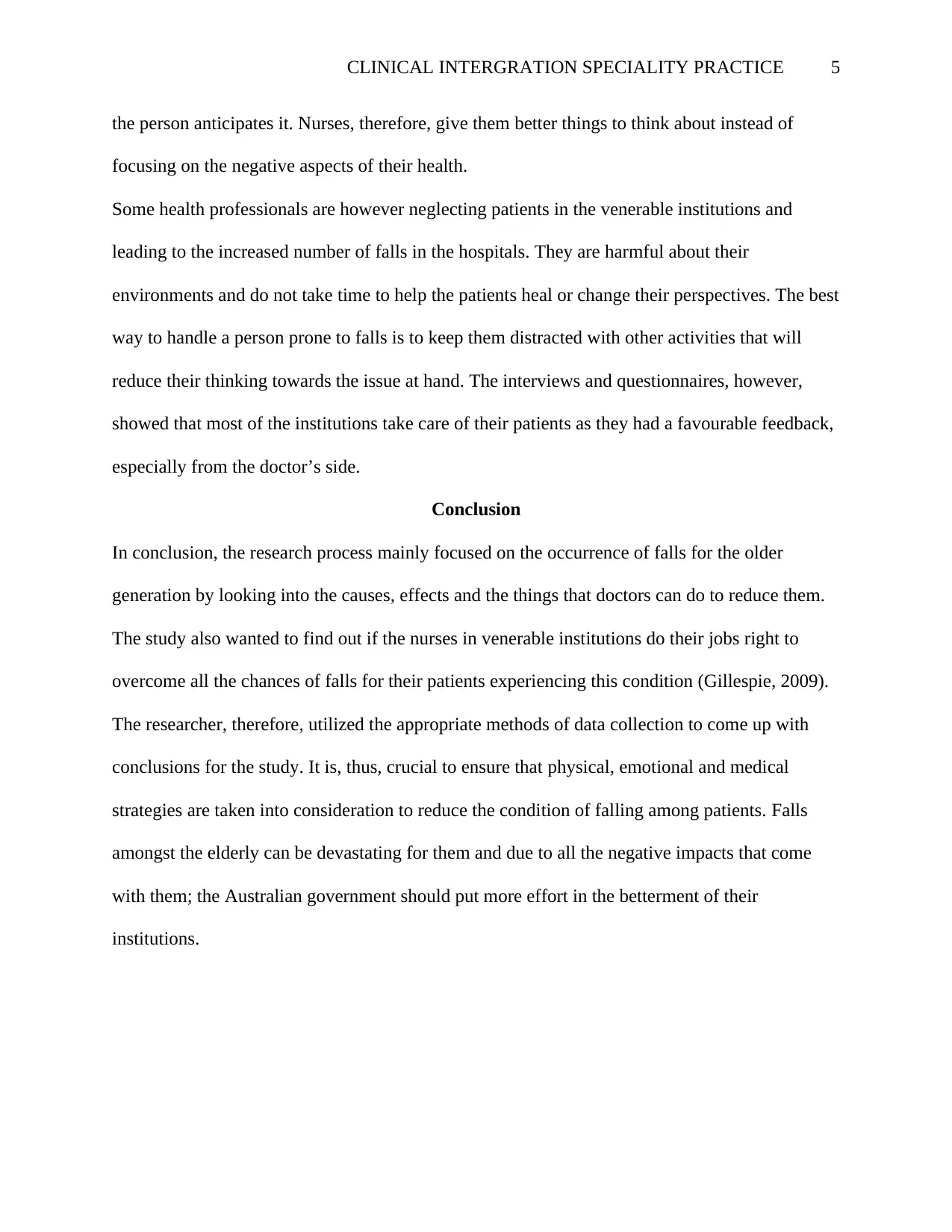
CLINICAL INTERGRATION SPECIALITY PRACTICE 5
the person anticipates it. Nurses, therefore, give them better things to think about instead of
focusing on the negative aspects of their health.
Some health professionals are however neglecting patients in the venerable institutions and
leading to the increased number of falls in the hospitals. They are harmful about their
environments and do not take time to help the patients heal or change their perspectives. The best
way to handle a person prone to falls is to keep them distracted with other activities that will
reduce their thinking towards the issue at hand. The interviews and questionnaires, however,
showed that most of the institutions take care of their patients as they had a favourable feedback,
especially from the doctor’s side.
Conclusion
In conclusion, the research process mainly focused on the occurrence of falls for the older
generation by looking into the causes, effects and the things that doctors can do to reduce them.
The study also wanted to find out if the nurses in venerable institutions do their jobs right to
overcome all the chances of falls for their patients experiencing this condition (Gillespie, 2009).
The researcher, therefore, utilized the appropriate methods of data collection to come up with
conclusions for the study. It is, thus, crucial to ensure that physical, emotional and medical
strategies are taken into consideration to reduce the condition of falling among patients. Falls
amongst the elderly can be devastating for them and due to all the negative impacts that come
with them; the Australian government should put more effort in the betterment of their
institutions.
the person anticipates it. Nurses, therefore, give them better things to think about instead of
focusing on the negative aspects of their health.
Some health professionals are however neglecting patients in the venerable institutions and
leading to the increased number of falls in the hospitals. They are harmful about their
environments and do not take time to help the patients heal or change their perspectives. The best
way to handle a person prone to falls is to keep them distracted with other activities that will
reduce their thinking towards the issue at hand. The interviews and questionnaires, however,
showed that most of the institutions take care of their patients as they had a favourable feedback,
especially from the doctor’s side.
Conclusion
In conclusion, the research process mainly focused on the occurrence of falls for the older
generation by looking into the causes, effects and the things that doctors can do to reduce them.
The study also wanted to find out if the nurses in venerable institutions do their jobs right to
overcome all the chances of falls for their patients experiencing this condition (Gillespie, 2009).
The researcher, therefore, utilized the appropriate methods of data collection to come up with
conclusions for the study. It is, thus, crucial to ensure that physical, emotional and medical
strategies are taken into consideration to reduce the condition of falling among patients. Falls
amongst the elderly can be devastating for them and due to all the negative impacts that come
with them; the Australian government should put more effort in the betterment of their
institutions.
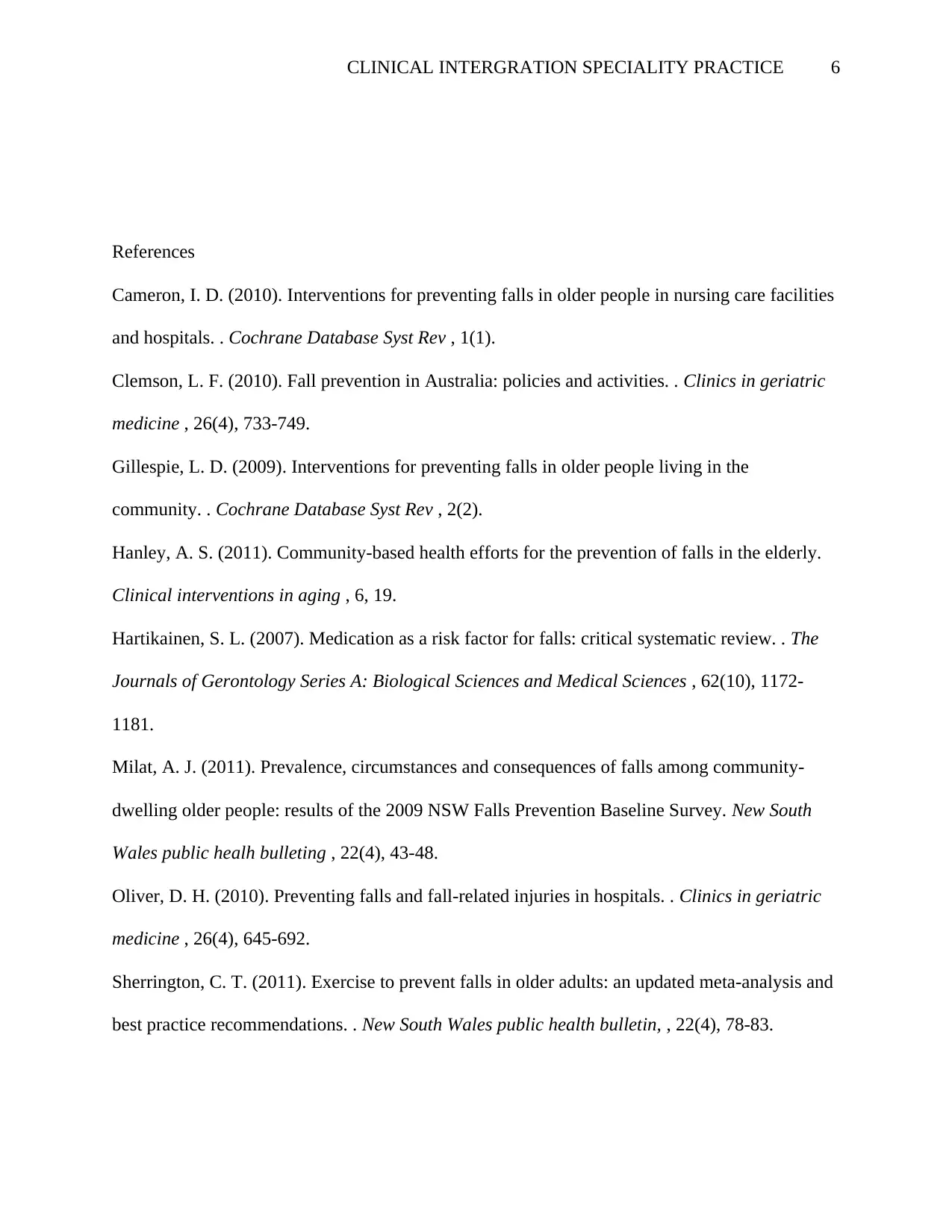
CLINICAL INTERGRATION SPECIALITY PRACTICE 6
References
Cameron, I. D. (2010). Interventions for preventing falls in older people in nursing care facilities
and hospitals. . Cochrane Database Syst Rev , 1(1).
Clemson, L. F. (2010). Fall prevention in Australia: policies and activities. . Clinics in geriatric
medicine , 26(4), 733-749.
Gillespie, L. D. (2009). Interventions for preventing falls in older people living in the
community. . Cochrane Database Syst Rev , 2(2).
Hanley, A. S. (2011). Community-based health efforts for the prevention of falls in the elderly.
Clinical interventions in aging , 6, 19.
Hartikainen, S. L. (2007). Medication as a risk factor for falls: critical systematic review. . The
Journals of Gerontology Series A: Biological Sciences and Medical Sciences , 62(10), 1172-
1181.
Milat, A. J. (2011). Prevalence, circumstances and consequences of falls among community-
dwelling older people: results of the 2009 NSW Falls Prevention Baseline Survey. New South
Wales public healh bulleting , 22(4), 43-48.
Oliver, D. H. (2010). Preventing falls and fall-related injuries in hospitals. . Clinics in geriatric
medicine , 26(4), 645-692.
Sherrington, C. T. (2011). Exercise to prevent falls in older adults: an updated meta-analysis and
best practice recommendations. . New South Wales public health bulletin, , 22(4), 78-83.
References
Cameron, I. D. (2010). Interventions for preventing falls in older people in nursing care facilities
and hospitals. . Cochrane Database Syst Rev , 1(1).
Clemson, L. F. (2010). Fall prevention in Australia: policies and activities. . Clinics in geriatric
medicine , 26(4), 733-749.
Gillespie, L. D. (2009). Interventions for preventing falls in older people living in the
community. . Cochrane Database Syst Rev , 2(2).
Hanley, A. S. (2011). Community-based health efforts for the prevention of falls in the elderly.
Clinical interventions in aging , 6, 19.
Hartikainen, S. L. (2007). Medication as a risk factor for falls: critical systematic review. . The
Journals of Gerontology Series A: Biological Sciences and Medical Sciences , 62(10), 1172-
1181.
Milat, A. J. (2011). Prevalence, circumstances and consequences of falls among community-
dwelling older people: results of the 2009 NSW Falls Prevention Baseline Survey. New South
Wales public healh bulleting , 22(4), 43-48.
Oliver, D. H. (2010). Preventing falls and fall-related injuries in hospitals. . Clinics in geriatric
medicine , 26(4), 645-692.
Sherrington, C. T. (2011). Exercise to prevent falls in older adults: an updated meta-analysis and
best practice recommendations. . New South Wales public health bulletin, , 22(4), 78-83.
⊘ This is a preview!⊘
Do you want full access?
Subscribe today to unlock all pages.

Trusted by 1+ million students worldwide
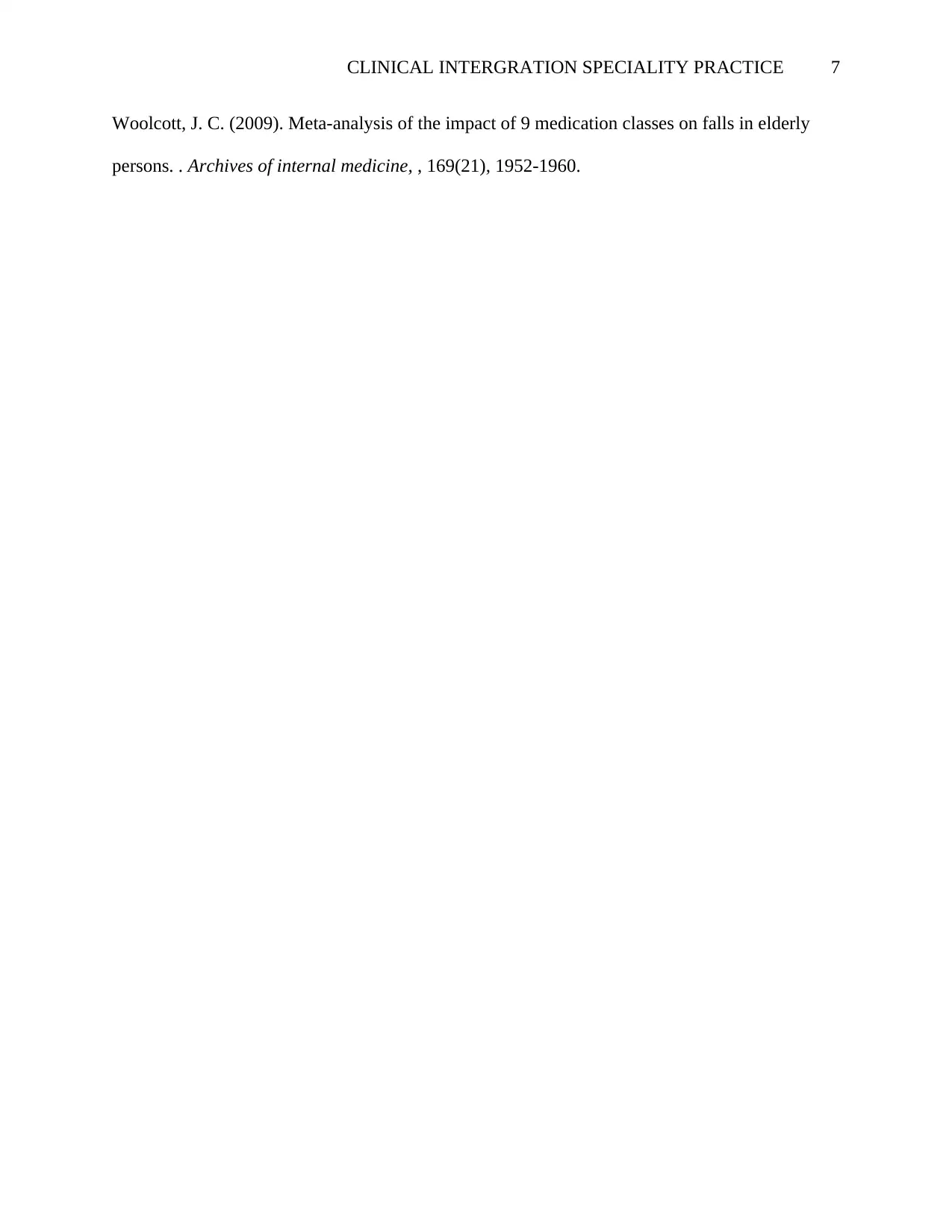
CLINICAL INTERGRATION SPECIALITY PRACTICE 7
Woolcott, J. C. (2009). Meta-analysis of the impact of 9 medication classes on falls in elderly
persons. . Archives of internal medicine, , 169(21), 1952-1960.
Woolcott, J. C. (2009). Meta-analysis of the impact of 9 medication classes on falls in elderly
persons. . Archives of internal medicine, , 169(21), 1952-1960.
1 out of 7
Related Documents
Your All-in-One AI-Powered Toolkit for Academic Success.
+13062052269
info@desklib.com
Available 24*7 on WhatsApp / Email
![[object Object]](/_next/static/media/star-bottom.7253800d.svg)
Unlock your academic potential
Copyright © 2020–2025 A2Z Services. All Rights Reserved. Developed and managed by ZUCOL.





